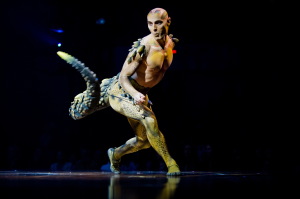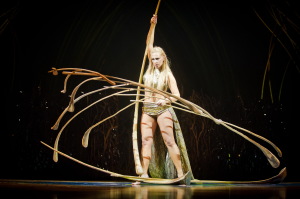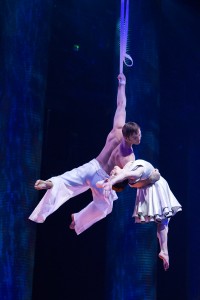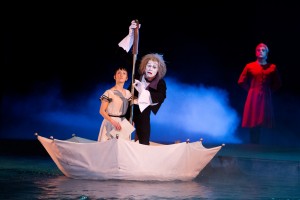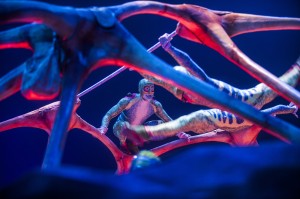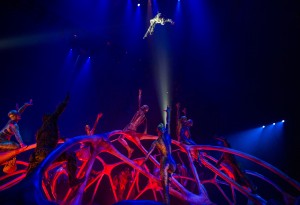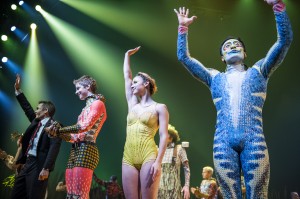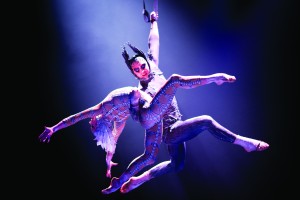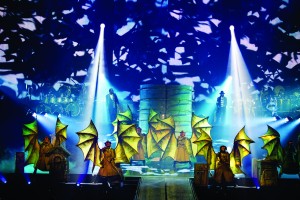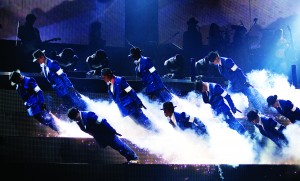Female performers are often central to the stories being told at Cirque du Soleil shows. But they have never been more celebrated than they are in Amaluna, which premiered in 2012 and features a cast of 70 percent women, with an entirely female band. A coming-of-age story told through music, dance, juggling, acrobatics and other amazing athletic performances, Amaluna follows Miranda as she not only begins her transformation into womanhood, but encounters her first male romantic interest when Romeo’s ship crashes on her island during a storm. Her transition is made complete during a spectacular performance in an enormous water bowl under the watchful eye of the Moon Goddess (and Romeo, who eventually can’t help but join her in the water). But there are many other important steps in Miranda’s growing process, which is a more tangible narrative than most Cirque shows told through some of Cirque’s most interesting acts to date. Rowenna Dunn, who has been Cirque’s touring publicist for eight years, tells Wrestling with Pop Culture what inspired Amaluna and where some of its more interesting acts were discovered.
I got to see the show during its opening weekend in Atlanta and noticed that it is a largely female cast with an entirely female band. Why was the decision made to do such a female-centric Cirque du Soleil show?
This is actually the 33rd production we have produced, and Cirque celebrated its 30th anniversary in January of this year, which was a pretty big milestone for us. Every time they create a show they try to come up with something different and something new for our existing fans as well as for our new fans. We’re changing with the times and keeping up to date with technology and things like that, so our shows that have been produced in the last couple of years are obviously much different than the show that were produced years ago. When the idea came up for this show, Guy Laliberté, our founder and owner, decided it was about time to really showcase women, their strengths, their acrobatic skill and their virtuosity. Traditionally with all of Cirque’s show, the ratio of the cast was about 70-80 percent male to 20-30 percent female. That wasn’t necessarily a conscious effort, that was just the way it fell. When this show came about, a conscious effort was made to really seek out these amazing female athletes, acrobats and artists to create the show. Similarly for the band, it’s the first time we’ve had a 100 percent female band.
The central story is a coming of age for Miranda as she becomes a woman.
Part of creating this show with a bit of a different twist and an emphasis on showcasing the strength, beauty and grace of women, we brought in Diane Paulus, who is a Broadway director and the artistic director of the American Repertory Theater at Harvard. She was brought in to bring a bit stronger narrative and more theatrical elements to the show. A lot of our shows aren’t necessarily telling a linear story, but in this case it was decided to have a very strong storyline. She drew upon a lot of classical influences, Greek and Norse mythology, a bit of a spin on Shakespeare’s The Tempest. That’s why you see Cali the lizard and Prospera, a female spin on Prospero. Diane has directed a lot of opera, so she drew from that background as she was creating this show, as well. It’s a linear storyline with a beginning, middle and end, but it is still very whimsical and open for interpretation.
You mentioned Cali, the male lizard character who seems to be Miranda’s protector. But he becomes a bit overprotective when she meets Romeo. Cali’s performance really stood out, even though this show is so female-centric.
He’s been her only pet and only companion on the island, so he sees Romeo as a threat when he arrives on the island. He’s been with the company for about 15 years and he created the role of the juggler on one of our other shows, Dralion, and has worked for a few different productions. That role was created with him in mind, so he was approached directly to say, “Hey. We’re creating this show and we have this storyline we’re putting together. We have this cast of amazing acts. How would you feel about creating this character?” With a lot of other disciplines and a lot of other theatrical performances, you might have somebody who would just do their main act on the stage and they’re not really doing much else throughout the show. But in this case Viktor Kee, who plays Cali, was really integral in creating that role and very invested in creating that role. You see him on stage for about 90 percent of the show. He’s pretty much on stage or in the audience or somewhere visible, in character, even when he’s not the main act.
The other act that was interesting to me was Lara Jacobs Rigolo and her intense stick balancing routine.
That’s our Balance Goddess. It’s demonstrating balance when Romeo is falling in love and trying to see if it’s going to work. That act was actually performed just as it was brought to us. We have a few different ways that we cast for our shows. We go out and find existing acts and existing pieces that we think would fit well into one of our existing shows, or maybe we have a bank of candidates we might draw upon at a later stage or use to replace an existing act. With that particular act, Lara’s father created it. So I guess he woke up one day and thought that was a good idea to start balancing those palm fronds one upon another and created a very beautiful and very lyrical act. So he was contacted by Cirque du Soleil to say, “Do you know any girls who know the act or can audition for it?” He said, “Yes. My daughter can learn.” She hadn’t actually done it before that point; he was the only one in the world that could do that particular act. So he flew to Montreal from Switzerland. She was actually in New York at the time, so she also flew to Montreal. He had about two or three days to teach it to her. He also taught it to a few other people who were auditioning for the act. She still had to audition and eventually won the role. I think there are two or three other people in the world who know it now. We actually have another girl who works in rotation and comes in and performs the act sometimes. He was charged with creating the act and maintaining the integrity of it. Cirque du Soleil said, “Wow! That’s beautiful. We want to integrate that into this particular storyline.” Alternatively, we will go to a lot of athletic competitions across Europe and around the world to draw upon the talents and skills and invite people in to create an act either in house or workshopping it together with another group of athletes.
I was actually going to ask how Cirque goes about discovering all the unique talents involved with its shows.
They go through days and days and days of views on YouTube, which is obviously the way of the future. But that one was pretty incredible and I know the creative team for this show drew a lot of inspiration from amazing female athletes, artists, acrobats, dancers and performers. So they have people that will send in videos of themselves for casting, but we do castings as well. Usually in the U.S. it’s a few times a year, we might go to Australia once a year, we might show up in a couple of different places across Europe. So it’s a lot of going through videos, seeing what’s trending on social media, seeing what new and different acts are popping up around the world. We’ve been doing this for 30 years and this is the 33rd production we’ve produced, so it’s very important to not just show the same old tricks.
Where can people see Amaluna over the next few weeks?
We’re in Atlanta through Nov. 30 then we head to Miami, which is a nice place to spend the winter months. We’re in Miami until the end of January, then we head to Houston. We have a little bit of a break after that before heading to Europe.
www.cirquedusoleil.com/en/shows/amaluna/default.aspx


